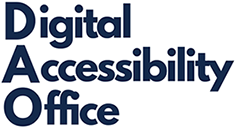Video and Audio
Multimedia, like video and audio, has special accessibility considerations. All users should be able to access the content in your video or audio recording regardless of format or disability. This generally means all videos need captions and all audio recordings need a transcript.
Captions
Captions are the text version of the audio information in a video or animation. The text synchronizes with the video’s action. They include all spoken words, identification of the speaker, and important sounds likes music or laughter. Captions benefit users who are deaf or have hearing loss, but they also help all users understand and remember information.
Keep in mind auto captions are never accurate, but you may want to use them in certain circumstances. For example, you can use YouTube’s automated captions as a starting point when adding closed captions on a video. Or you may turn on Zoom’s live transcription for live auto captions during your next meeting.
We recommend signing up for our Captioning training to learn more about the ins and outs of captioning.
Transcripts
Transcripts provide the text version of audio content in a video presented in a different format. NPR’s interview, For Author Kevin Wilson, Writing Offers A Brief Reprieve From Tourette’s, is a good example. Transcripts help users who are deaf, have difficulty seeing visual information, or have multiple disabilities like deaf-blindness.
Audio description
Audio description provides audible information that isn’t described or spoken in the main soundtrack of a video. This includes important actions, characters, scene changes, and on-screen text. Users who are blind or low vision benefit most from audio descriptions. They also benefit users who have difficulty understanding visual information.
The following videos are examples of a scene with and without audio description. (Try turning around or closing your eyes while listening to the videos.)
